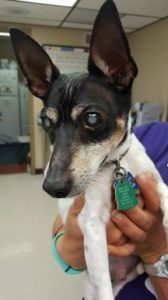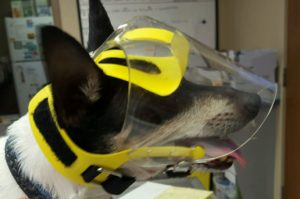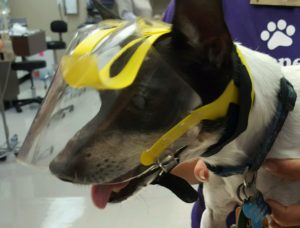The Case of the Squinty Eye
“I woke up this morning and Fluffy couldn’t open her eye!”
This is something that our doctors at Temperance Animal Hospital hear frequently. There are several painful conditions of the eye that can cause your pet to hold one or both eyes closed. These include: corneal ulcers, glaucoma (a painful increase in pressure within the eye), trauma, foreign bodies and uveitis (inflammation inside the eye). Whenever changes with the eyes are noted, an exam with one of our veterinarians is advised. Eyes are important to our pets and things can go from minor to serious in a very short period of time so prompt attention is crucial.
The most common eye condition we see in our practice is a corneal ulceration. A corneal ulcer or erosion is essentially an area of injury to the cornea, which is the clear tissue that covers the surface of the eye. These can be caused by a variety of things including: scraping or bumping the eye on something rough, dust, chemicals splashing in the eye, decreased tear production or hairs / eyelashes rubbing on the eye.
Most corneal ulcers are superficial, with only the surface layer of the cornea being damaged. Although painful, superficial ulcers typically heal quickly (with treatment) most pets will recover in 5-7 days. One of the most important components of treatment for ulcers is protecting the eye from further injury. Since ulcers are painful, they are irritating to our pets and they frequently try to rub the eye with their paws or on household objects. An e-collar or protective face shield is usually prescribed to help protect the eye while the ulcer heals. Topical antibiotics are used to help prevent infection and pain medication is prescribed for comfort. If an underlying cause is identified, it must be corrected for the ulcer to heal. A return visit to the veterinarian is scheduled at the end of treatment to ensure the ulcer has fully healed.
In some cases, ulcers can involve the deeper layers of the cornea or fail to heal completely (these are called an indolent ulcers). These conditions require special care in order to prevent more serious complications. Deep ulcers often require surgery or advanced medical therapy to prevent rupture of the globe. Non-healing or indolent ulcers are best treated with a special procedure called a keratotomy / keratectomy. The goal of a keratotomy procedure is to provide a “grippy” surface for the corneal epithelial (skin) cells to adhere to as they grow across the ulcer. Traditionally, a needle has been used to perform a so called “grid keratotomy”. Recently, a specialized instrument called an Alger brush has been developed and is used with a fine-grit diamond coated burr to gently roughen the corneal surface. Our doctors have all been trained in this new “Diamond Burr Keratotomy” technique and have been enjoying great success using this to help some of our difficult ulcer patients heal!
Dr. Whitmer recently had a challenging corneal ulcer case that illustrates the benefits of the new Diamond Burr Keratotomy technique. Eddie is an 11 year old Toy Fox Terrier who has a history of recurrent and indolent corneal ulcers. Because Eddie is diabetic, he has developed cataracts and is now blind. This means that he has a tendency to bump in to things around the house. He also has slightly low tear production which makes his corneas more fragile. After the third time that he developed ulcers (now in both eyes), his owners and Dr. Whitmer were understandably frustrated. It was elected to perform a diamond burr keratotomy to help get his eyes healed up. Eddie hated having to wear an e-collar as it made it very difficult for him to navigate around the house. His owners purchased an Optivizor face shield to protect his eyes while they were healing. He will also wear this long term to help prevent the ulcers from coming back. Eddie had his Diamond Burr Keratotomy under light sedation and topical anesthetic and a week later his eyes look beautiful! He is comfortable, his ulcers have healed and he is enjoying life with his Optivizor – now Eddie, his dedicated owners and Dr. Whitmer can breathe a sigh of relief!



